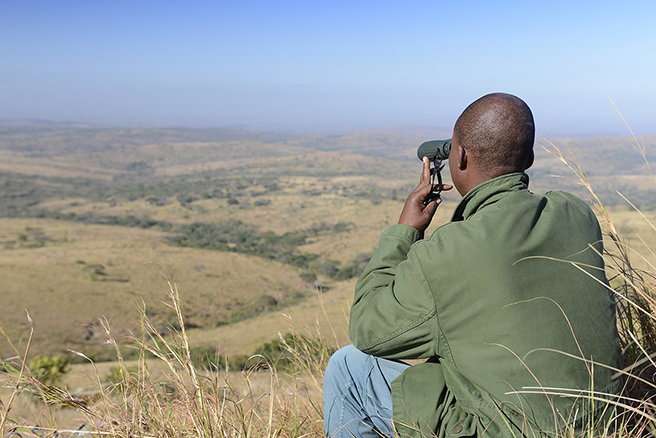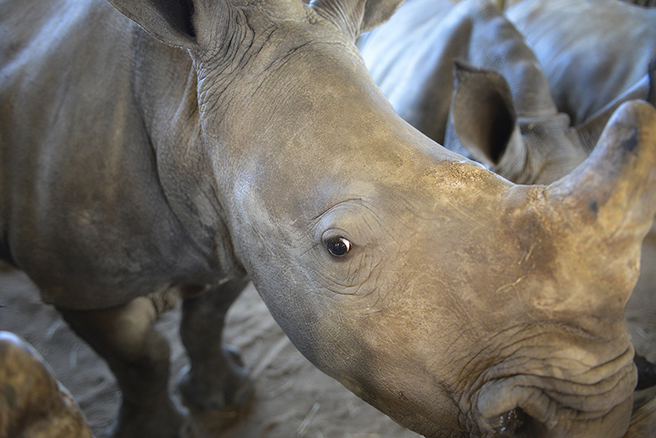Rhinos at Hluhluwe iMfolozi Park, South Africa

The rugged hills of Hluhluwe iMfolozi Park, located in KwaZulu-Natal, South Africa are golden and bright during the winter months, and the short, dry grass sways to the rhythm of a near constant breeze.
Narrow, rocky streams traverse the landscape but they are, for the most part, dry at this time of year. The exceptions are the two primary branches of the IMfolozi River. They sparkle with the reflection of cloudless blue skies, both flowing steadily to their confluence on the eastern border of the reserve. This is gorgeous country, and it is home to an impressive variety of fauna. All the great cat species can be found here, along with elephants, hippos and wild dogs. The antelopes are prolific, with kudu, nyala, waterbuck, and far too many impala to count. And for now, it is home to a healthy population of both black and white rhino.
The rangers at Hluhluwe iMfolozi are among the busiest people you will ever find. With 24,000 hectares to monitor and expansive and porous boundaries in all directions, these dedicated and hard working professionals have their work cut out for them. They contend with a normal workload of tourist and wildlife issues, but like so many of their counterparts in Africa’s great game parks, they must also battle the ongoing poaching epidemic.
During our recent visit, the park’s management provided us a comprehensive tour and clearly defined the extent of their daily challenges. Protecting the rich and diverse wildlife of Hluhluwe iMfolozi is no easy matter, even when the short grasses of the winter season offer reduced cover for malicious infiltrators. Rhino poaching has been on the increase here in recent months, with six white rhinos murdered in calendar year 2013 alone. Most of these incidents have taken place along the park’s eastern corridor in the section that is geographically closest to the southern entrance. The most recent attack was just over a week ago (the date as I write is June 19th), and the unfortunate victim was an adult female white rhino.

Even with 24 hour watches posted at key locations throughout Hluhluwe iMfolozi, time/distance constraints prevent an instantaneous ranger response to poaching or other problems. The ranger team requires greater mobility to move both on and off road, they need camping gear to position rangers deep in the bush and, because the poaching business is intrinsically violent, they must have bullet proof vests as well. Some of the needed help is on the way as a result of a recently approved grant from the African Wildlife Foundation*. Ranger Sithembiso Ndlovu and his team are already feeling the positive impact of AWF’s help. “We appreciate that the African Wildlife Foundation has come on board to help us with this precious business of conservation. Our role is to make sure that these rhinos exist for future generations. Believe me; your contributions will not be wasted.”
Our tour of Hluhluwe iMfolozi concluded with a visit to the compound that holds the living, breathing consequences of the mindless human lust for rhino horn. Four orphans are currently housed in a boma within the reserve’s boundaries. The hour spent with them was one of the most moving and powerful experiences of my life. It’s difficult to believe that anyone – including the most nefarious players in the poaching syndicate – could spend a little time with these innocents in the paddock and not be touched by the absolute moral wrong we are visiting upon this magnificent species. These beautiful and bewildered young rhinos deserve a better fate, and the park staff is committed to rearing and nurturing them all the way to adulthood. It’s more than a simple love for the animals that drives the rangers to care for these orphans; it’s also a deep and abiding sense of justice and right.
To be continued … because my hour at the boma merits its own blog post. More soon.
*The grant was made possible by the Flora Family Foundation and Fondation Philanthropia Lombard Odier